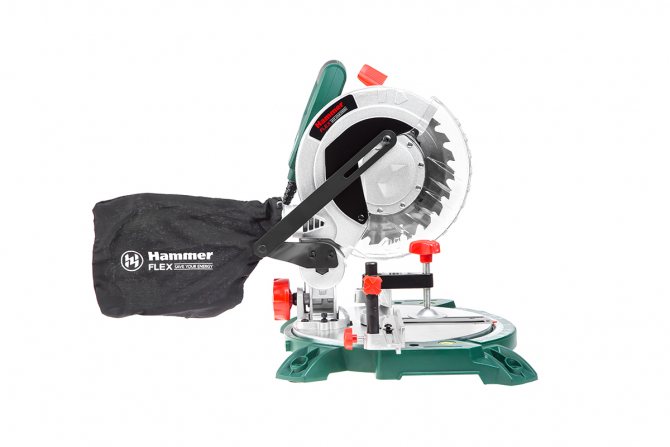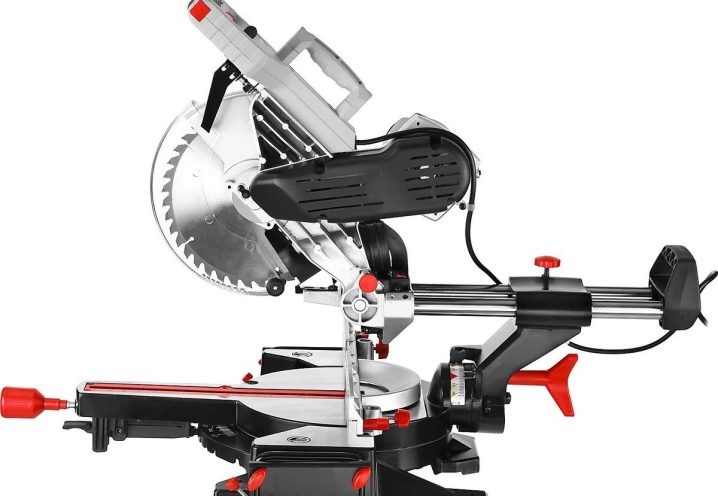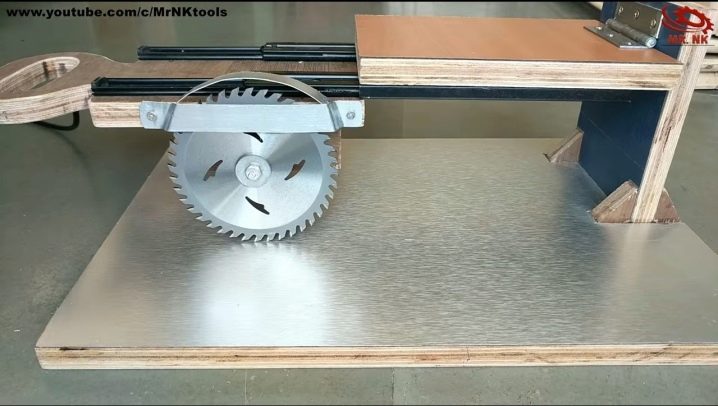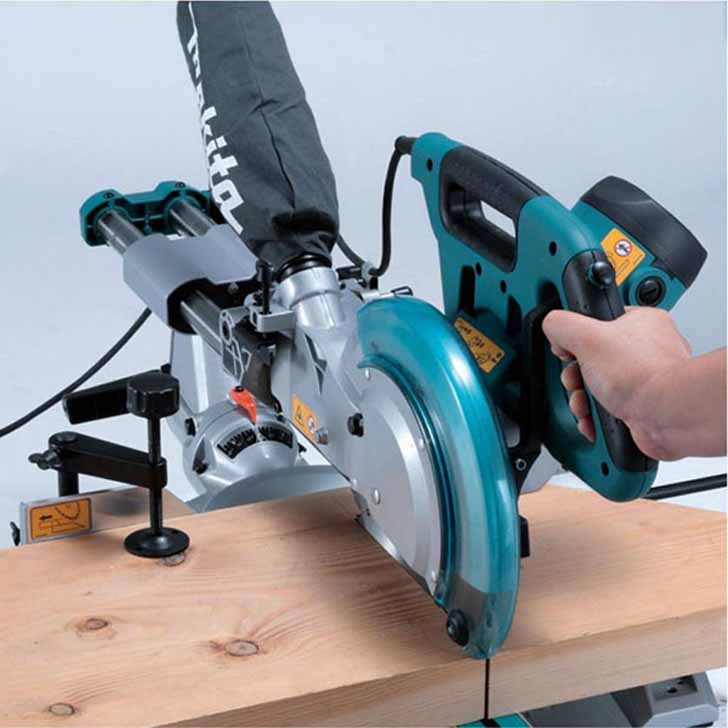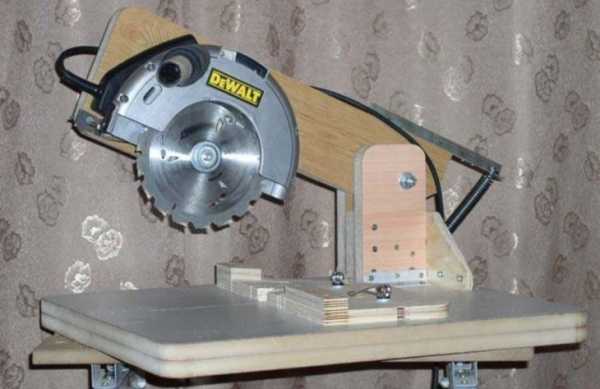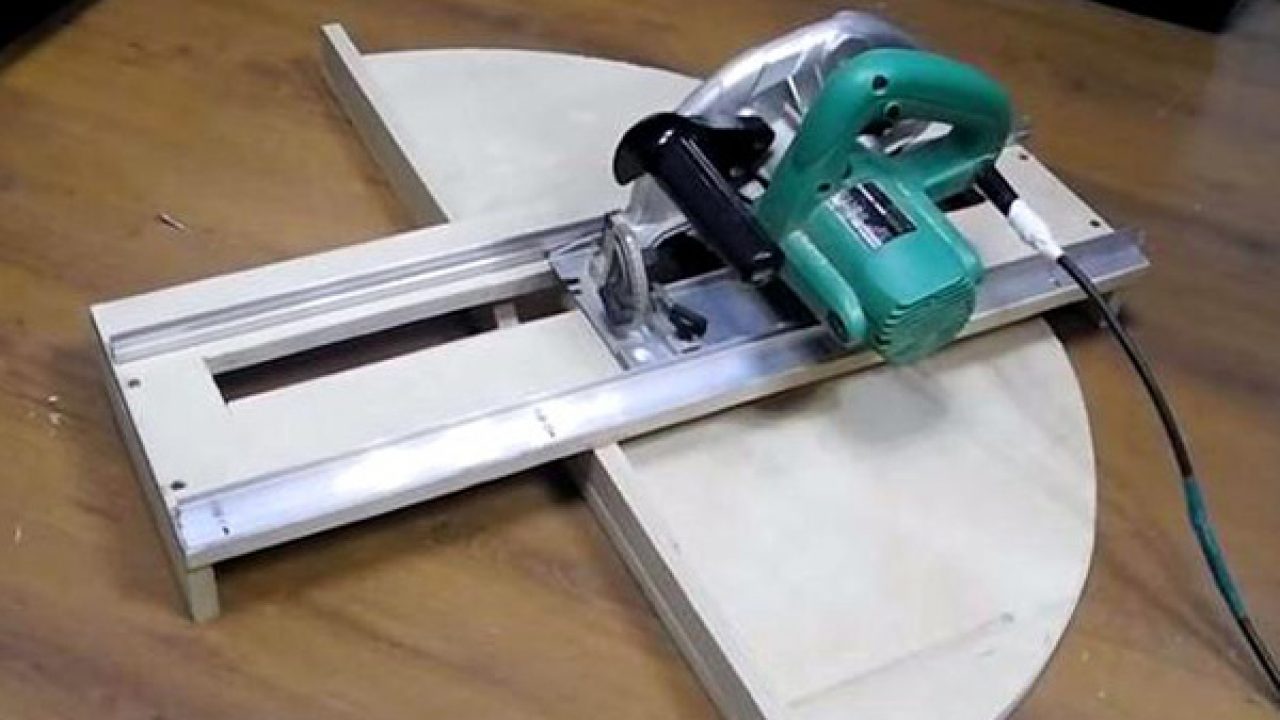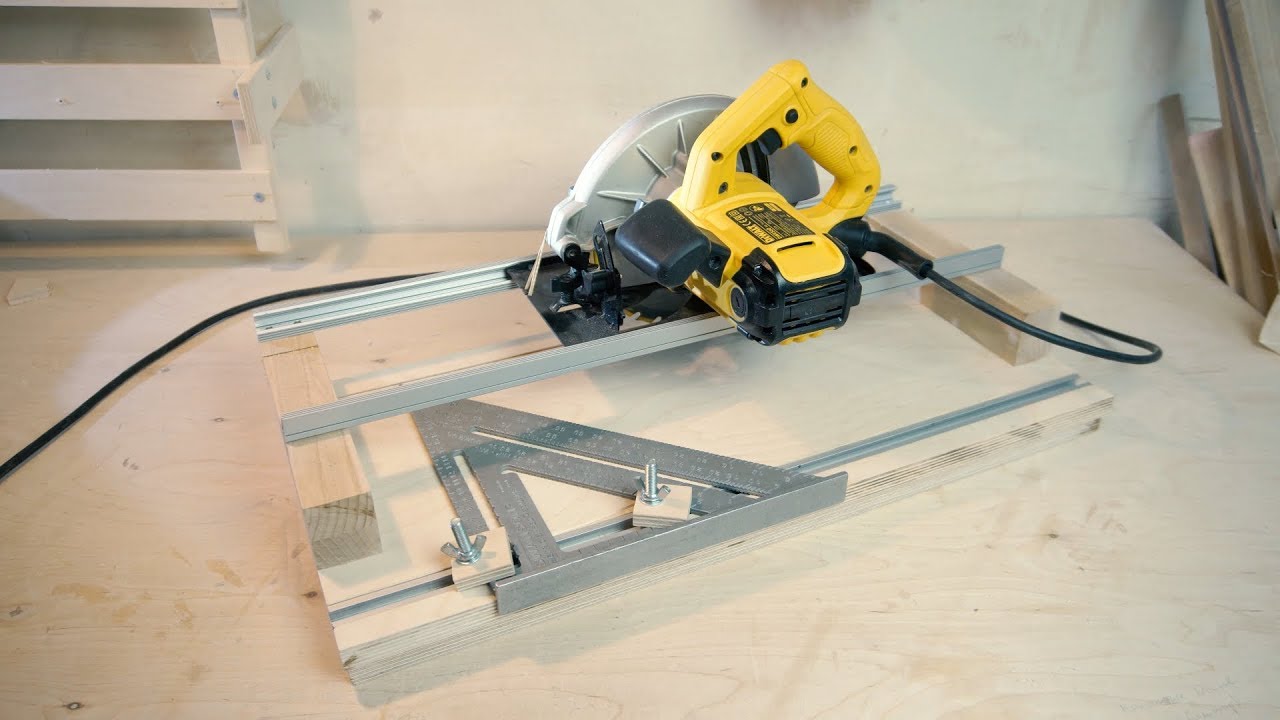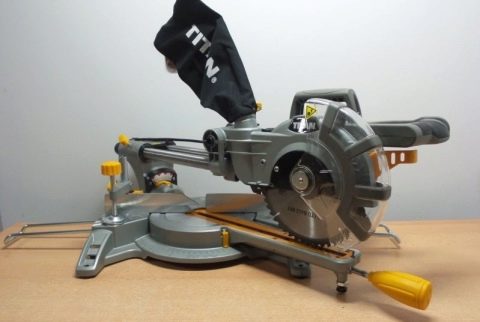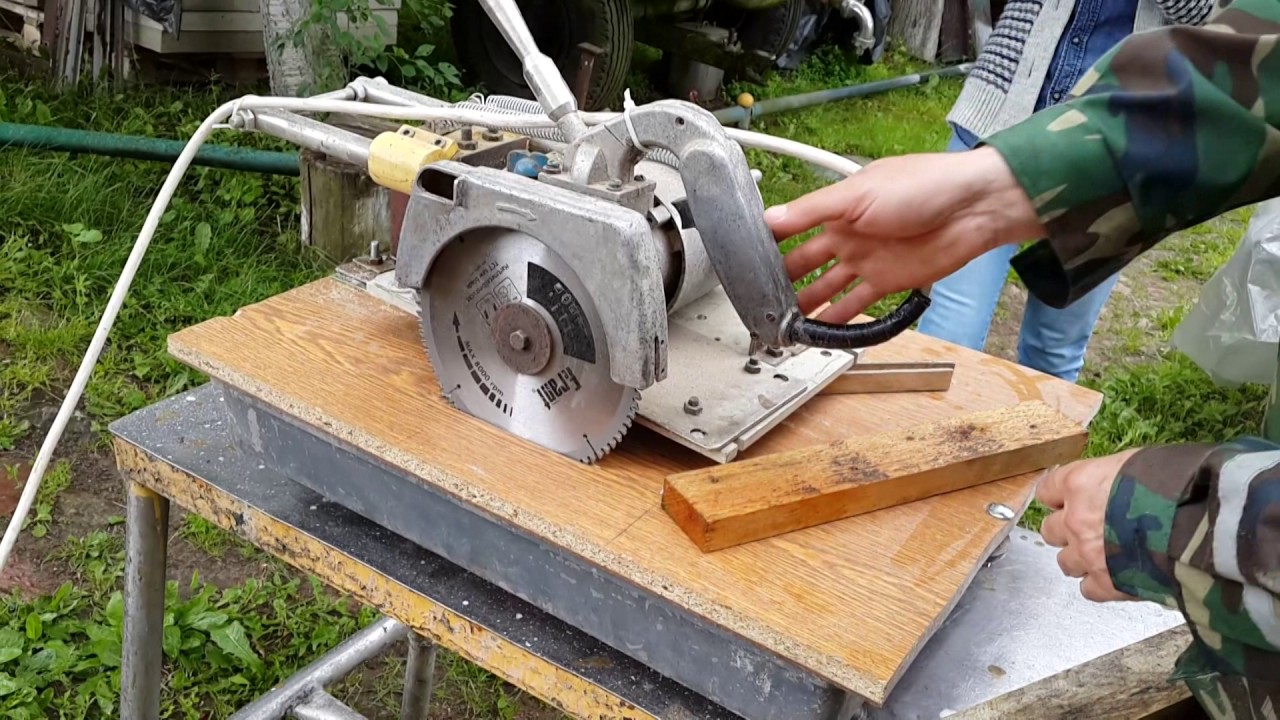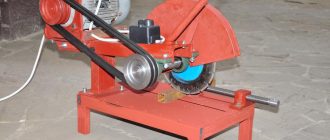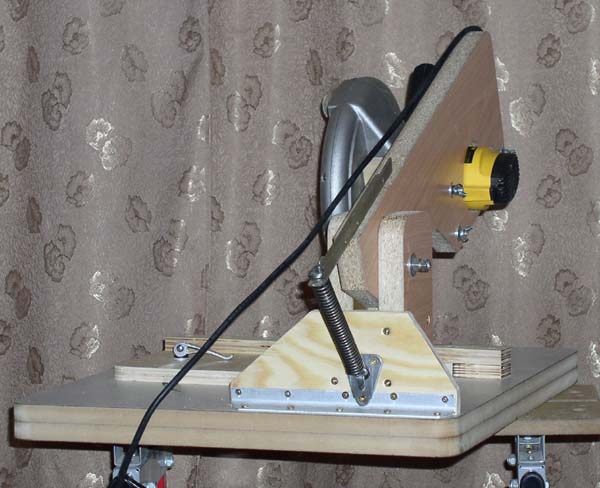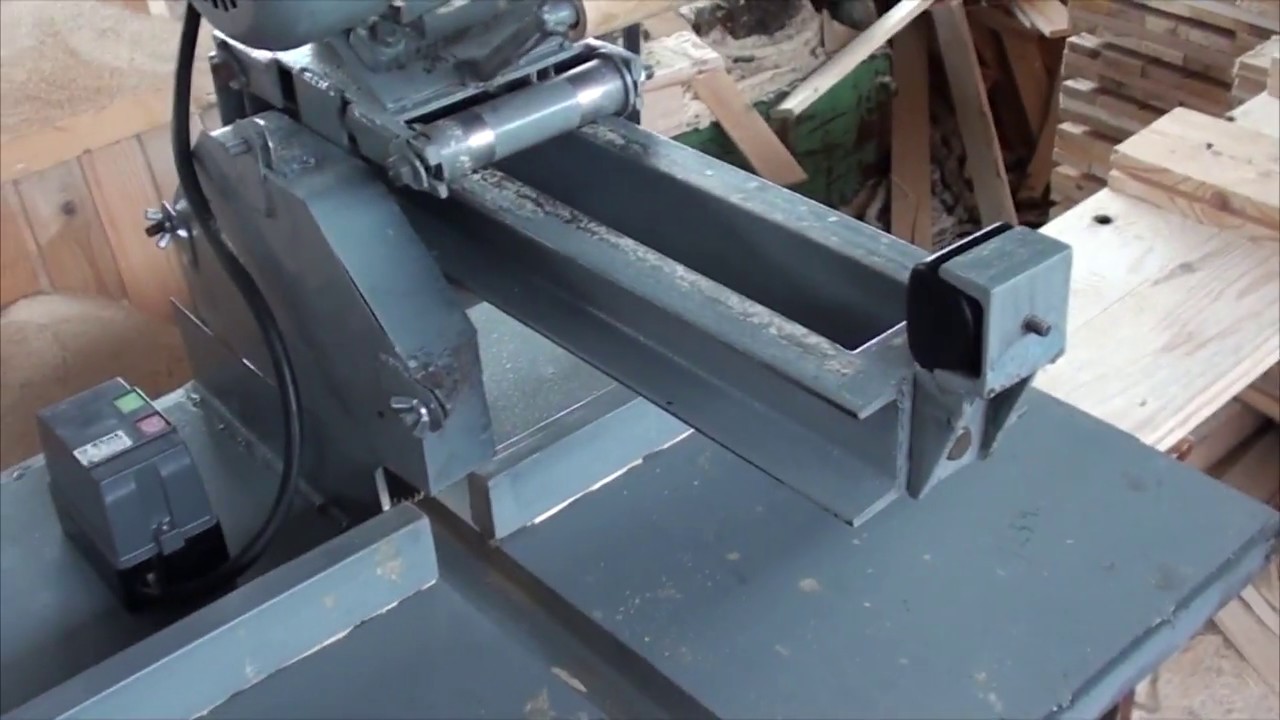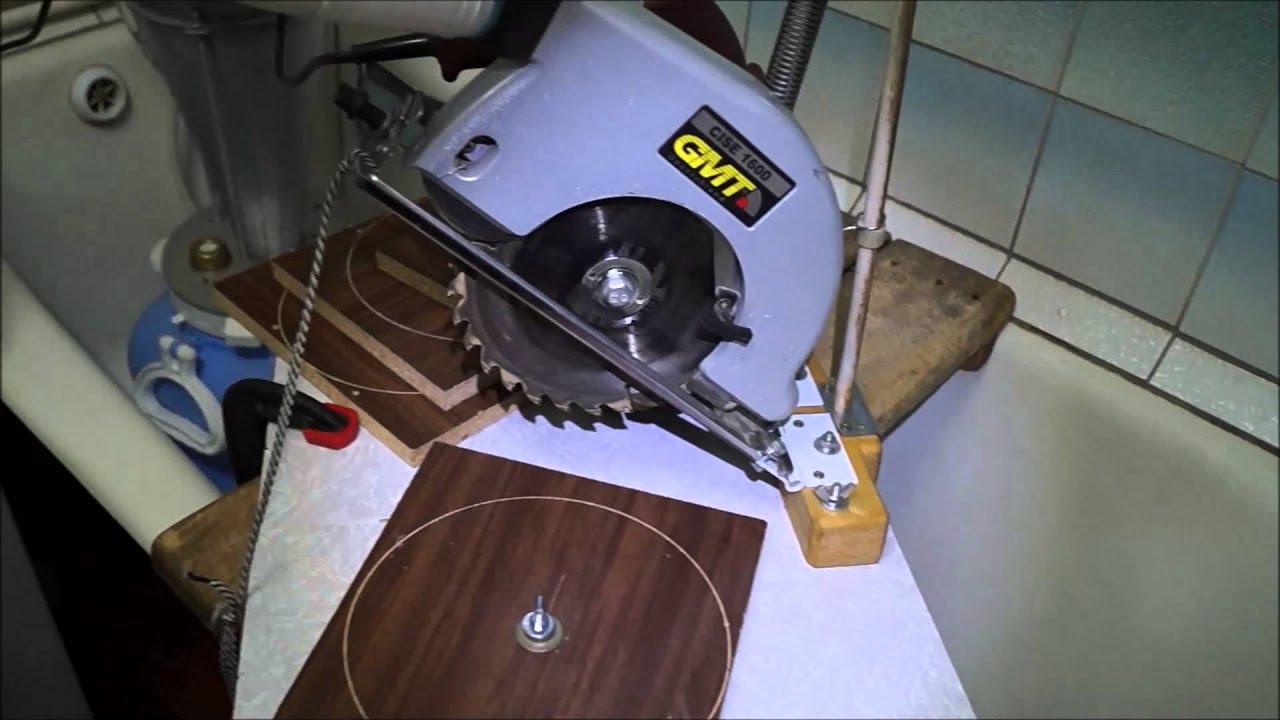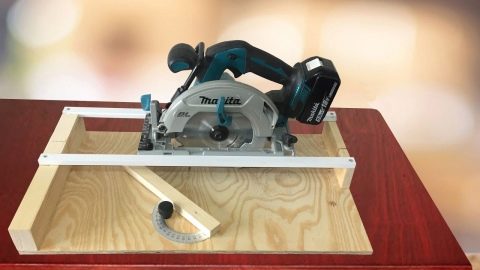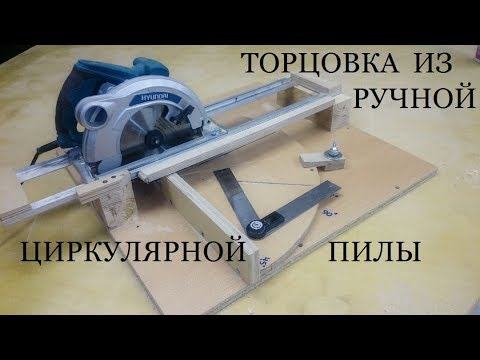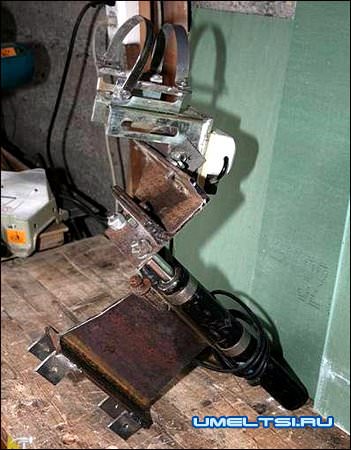Varieties of miter saws for wood
The modern power tool market can offer a large selection of a wide variety of miter saw models, which may differ in the following parameters and design features:
- the type and power of the engine, as well as its location;
- the type of gearbox that transmits the torque from the motor shaft to the saw blade;
- the presence of an electronic system, which is needed to maintain the speed of rotation of the disk when cutting it into the thickness of the workpiece material;
- the presence of a broach system, which allows the saw blade to have a horizontal stroke, which ensures cutting of wide workpieces;
The feed allows the disc pendulum to move horizontally along the notch, allowing wide lumber to be trimmed
- the standard size of the discs used.
Miter saws are equipped with three types of motors:
- asynchronous;
- collector;
- valve.
Asynchronous type electric motors are reliable, economical and work without creating much noise. Their disadvantages are their large weight (up to 20 kg) and low power, which does not allow them to reach speeds of more than 2800 rpm. For these reasons, such motors are rarely used in pendulum saws.
Brush type motors are more compact and lighter in weight. They can reach speeds of up to 5-10 thousand revolutions per minute, but when the collector brushes are working, they create a certain level of noise. Such a motor requires periodic maintenance, consisting of replacing the brushes, but despite this, it is used in most models of miter saws.
Electric motors of the third type, valve type, are the most modern and perfect device, which takes all the best qualities of asynchronous and commutator motors. Instead of a brush unit, they have an electronic unit that allows a high speed of rotation of the motor shaft to be achieved. But such motors are quite expensive, and are used only on high-quality miter saws of the highest price segment.
By the type of gearbox used, pendulum saws can be belt-driven or gear-driven. Of course, gears provide more reliable traction and better transmission of torque. But they create additional noise during operation, and in case of failure of the gear-type gearbox. difficult repairs in a specialized service will be required. At the same time, the belt can be easily replaced by yourself, and it works almost silently. In addition, the belt drive dampens disc vibrations and extends bearing life.
It is very important to stabilize the speed of the saw blade under load to obtain a high-quality cut, especially in hardwoods and tough composites. For this, in most modern miter saws, a special electronic unit is provided.
Electronics is widely used to create more comfortable working conditions with this tool, namely:
- to ensure a smooth start of the engine;
- for its braking when the motor is turned off;
- for various safety interlocks to ensure the safety of working with the cutting power tool.
The presence of electronics in different models gives them additional advantages, but also leads to an increase in the cost of the miter saw. The more functions this tool has in its design, the more convenient it is to work on it.
In recent years, broach miter saws have become increasingly popular.The two rods, on which the pendulum with the cutting head is mounted, allow the saw blade to be moved to produce a high-quality, even cut on a wide material.
Pendulum saws also differ in the size and type of saw blades used. The main parameters of the saw cutting element are:
- landing diameter;
- outside diameter;
- the number of teeth - the larger it is, the better the cut will be;
- disc thickness;
- maximum rotation speed.
All these parameters are printed on the disc itself, in a certain place. Cutting thinner workpieces (eg laminate) will require a disc with a larger number of teeth.
 It is possible to use for specific models of miter saws only a certain size of the disc for which the tool is designed
It is possible to use for specific models of miter saws only a certain size of the disc for which the tool is designed
Types and characteristics of saws
The miter saw will be an indispensable tool when you need to make  precise neat cut. In most cases, such a tool is used by professionals in carpentry workshops, in the manufacture of furniture and in interior decoration. For this type of work, a clean and even cut is a prerequisite. Miter saws can be divided into two main categories. The first category includes a separate trimming, without additional superstructures. The second category is combination saws.
precise neat cut. In most cases, such a tool is used by professionals in carpentry workshops, in the manufacture of furniture and in interior decoration. For this type of work, a clean and even cut is a prerequisite. Miter saws can be divided into two main categories. The first category includes a separate trimming, without additional superstructures. The second category is combination saws.
The difference between these two types is that the combined top has an additional sawing table. This allows it to be used not only as an end but also as a small stationary circular. The price of these devices is noticeably higher than that of the versions for home use.
How to make a miter saw
Let's start assembling
- We cut out a rectangular sheet of plywood and make a long cut on it, along which your trimming will ride;
- From above we fasten two guides, for example, from an aluminum corner, to the width of the working plane of the circular itself;
- From the bottom to the plywood sheet you need to screw two supports with a height equal to the cutting depth of your saw (5.3 cm).
As a result, we get a guide along which the circular will walk. Depending on how we fix it on the table with such a simple mechanism, we can make an accurate cut at any angle. The simplest design option is ready.
What if we want our miter saw to be more functional at work and look like a factory miter saw? In this case, you will have to show more ingenuity.
- First, you need to make a bracket and a stand on which the circular will be fixed. Chipboard (27 mm) is an excellent raw material for such a mechanism. With the help of self-tapping screws and aluminum corners, you will get a very decent top end. And the springs fixed on top can make the work on such a saw more convenient;
- Secondly, you need to fix the tripod itself on a movable pivoting footboard, make a pendulum saw, thanks to which we will eventually be able to change the facing angle.
Carefully! What material you choose for the stand and tripod, how securely you attach them to the footrest, will depend not only on the quality of work and functionality of the trimming, but also your personal safety. No wonder they say that if a carpenter is experienced, then he is sure to be without a finger
Secure the circular as securely as possible! Safety is above all!
As for the trimming itself, everything is said about the assembly. However, if we decided to make a saw that looks like a factory saw, then it will be difficult to do without a table.
Making a cutting tool with your own hands
As one of the options for the independent manufacture of a cutting tool, the case can be considered when an angle grinder (grinder) is used, which has already worked out its due date. The operating parameters of the mechanism can be based on the characteristics of trimming with a broach, designed for the following parameters.

The engine speed is about 4500, and the length of the formed cut is 300-350 mm (the second indicator is much higher than that of the branded models of the middle class).

The moving part of the future self-made device is made on the basis of an old car wheel with a kingpin, on the outside of which an eyelet is welded to the bearing housing to fix the base with a grinder. The latter is fixed to the body by means of M6 screws.
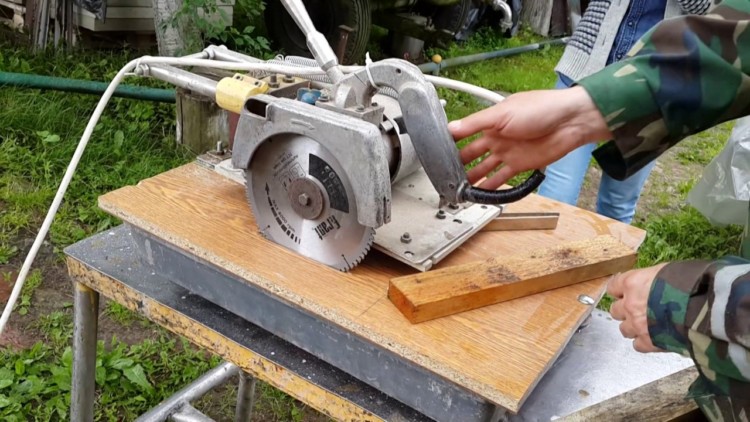
To prevent chips from entering the user's face, the resulting structure is closed from above with a protective box. The broaching mechanism is made from old shock absorbers from a truck. First, oil is poured out of them, and then ventilation holes are drilled in the cases (later they are closed with a special mesh that protects the mechanism from dust and chips).
In order to avoid a sharp jerk, well felt when the grinder is turned on, the tool being manufactured is equipped with a special module that reduces the speed during start-up.
> In the final part of the review, we should once again remind you of the safety of working with wood trimming, which belongs to high-speed mechanisms with a cutting disc. All this forces us to take special protective measures when handling it, which consists in the use of glasses and thick canvas gloves.
Advantages
When a tool (and even more so a machine) is made independently, then its design, as a rule, takes into account as much as possible those needs and tasks that are supposed to be solved with its help:
- so that molded parts do not have burrs and creases during cutting, it is necessary that the circular saw has an adjustable speed of movement relative to the cut plane (so that the burrs are removed by the cutting edges of the saw teeth);
- suppose you need to make not the usual transverse trimming of molded products, but at a certain angle. In this case, it is necessary that the workpiece be fixed in order to avoid backlash during the cut;
All these features are inherent in home-made designs of cross-cutting machines, which makes their production on their own justified and profitable.
Miter saw blades
When choosing a miter mechanism suitable for home conditions, special attention should be paid to the dimensions of the saw blade, the diameter of which should not be less than 20 cm.Also, one should not forget about such important characteristics of the purchased device as the width and depth of the saw cut

We should not forget that a large disk size is considered good from the point of view of optimal operating conditions, using which it will be possible to operate it for a rather long time and efficiently.
> Based on all these indicators, it is possible to choose the required model of the cutting tool, the level of performance of which will meet the requirements for it.
We assemble the table with our own hands
An assembly of a tool can be conditionally divided into work with several parts of it. Its main components include a frame, side extensions, side stops, pressure plates and a base-platform for the saw.
Let's consider each part in order of importance.
Frame
The frame of the product is best made from a metal profile (aluminum or steel), and its section is usually chosen from the existing assortment in the store. The dimensions of the frame, as fundamental for the table, are determined by the free space around, the dimensions of the cutting element and the type of product (not movable or mobile).
In accordance with the dimensions of the saw you are considering, the level of the lower line of the potential cut and the possibility of changing the position of the saw on the bed are laid in the frame structure.



Side extensions
In the course of interaction with especially bulky materials in the table, they provide for the installation of side extensions made of metal, a durable sheet of plastic or wood.Upon completion of processing, due to their design, they are lowered on the sides of the installation.
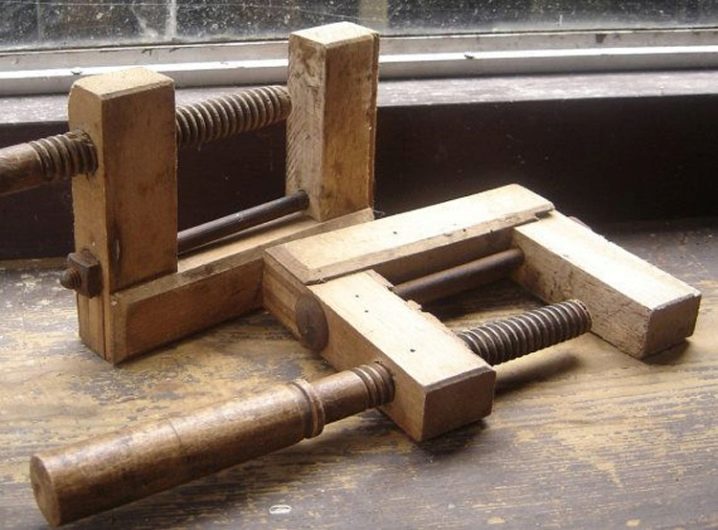
Side stops
To facilitate the milling process, parallel side stops are fixed on a homemade table.
With their help, the corners are attached to the working miter table.


Pressure plates
A metal profile is chosen as the pressure plates on the table and equipped with a device for rigid fixation with the surface. Plates are installed as follows: one element is placed under the working surface, and the second is above it. Next, the bolted connection is tightened, tightly squeezing the materials together.


Saw assembly
After assembling the metal frame and assembling the extensions, stops and pressure plates, you can proceed to the final stage. The installation of the miter saw consists in placing it on the base-platform and fastening the parts with screws.


Reliability check
The final step is to check the integrity and overall reliability of the miter table.
The overall reliability of the table is assessed by trial work.

The table for a miter saw is a device that serves as the basis for installing this type of saw, facilitating the execution of work on face processing of various types of materials both in a strictly vertical plane and at the required angle.



